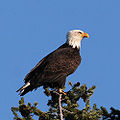Talk:Eagle
Parked for possible reinsertion after rewrite...
Ecology
Eagles can be roughly divided into four groups based on their physical characteristics and behavior.
- Sea or Fish Eagles
Eagles in this group mostly live on the forested shores of lakes, rivers, and oceans. They favor fish. Nonetheless, the Vulturine Fish Eagle is almost a vegetarian, living mostly on the fruit of the oil palm. Some of the sea and fish eagles live in threatened habitats.
- Snake or Serpent Eagles
Eagles in this group are smaller than other eagles. Savannas and forests of tropical Europe, Asia, Australia, and Africa are where they usually hunt. The Madagascar Serpent Eagle, which is in this group, is one of the most endangered raptors in the world. Many snake and serpent eagles, especially those of the genus Spilornis, live in a very restricted range. Any destruction of their habitat can affect them critically.
- Booted or True Eagles
The Booted Eagles got their name due to their feathers that covered right down to their ankles. This group contains most species. Martial Eagle, Eedge-tailed Eagle, and Verreaux's Eagle are the largest eagles in the world, while some other eagles including Wahlberg's Eagle and Ayres's Hawk-eagle are the smallest eagles in the world.
- Harpy or Buteonine Eagles
Although other eagles are powerful birds of prey, the Harpy Eagles of South America are the world’s most powerful eagle. A female harpy eagle can weigh nearly 20 pounds and have big legs with 1.5 inch-long talons which can span 9 inches. Using these powerful bodies, they hunt sloth and howler monkeys. [1]
Gallery
Bald Eagle
(H. leucocephalus)
Genus: HaliaeetusSolitary Eagle
(H. solitarius)
Genus:HarpyhaliaetusHarpy Eagle
(H. harpyja)
Genus: HarpiaBateleur
(T. ecaudatus)
Genus: TerathopiusFlying Bald eagle
(H. leucocephalus)
Genus: HaliaeetusBald eagle
(H. leucocephalus)
Genus: HaliaeetusMartial Eagle
(P. bellicosus)
Genus: Polemaetus






